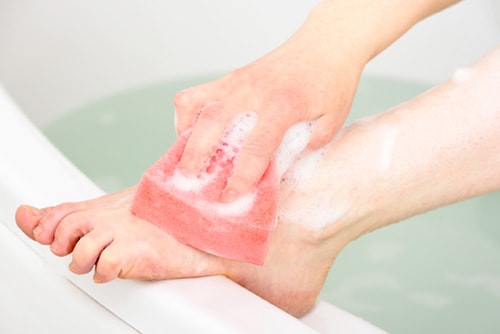Key points
- Athlete's foot, diabetes, fungal infections, and hookworm are conditions linked to hygiene.
- Prevent diseases and foot problems by taking care of your feet.
- Wash your feet daily and wear well-fitting, protective footwear.

Why it's important
Foot hygiene is good for your health. Several foot-related conditions are directly related to hygiene.
Ringworm and fungal nail infections
Tinea pedis, often called athlete's foot or ringworm, is an infection of the skin and feet that can be caused by a variety of fungi that thrive in warm, dark, and moist environments. Although tinea pedis can affect any part of the foot, the infection most often affects the space between the toes. Good hygiene practices, like keeping your feet and toes clean and dry and changing your shoes and socks regularly, help to prevent or control tinea pedis.
Fungal nail infections are common infections of the fingernails or toenails that can cause the nail to become discolored, thick, and more likely to crack and break. Small cracks in your nail or the surrounding skin can allow these germs to enter your nail and cause an infection.
Diabetes
Diabetes can damage the nerves and affect blood flow in feet and legs. Poor foot hygiene can put you at an increased risk for infection.
Hookworm
Hookworm is a parasitic worm (also called a helminth). Globally, it is one of the most common roundworms found in humans. Hookworm infection is most common in resource-limited settings with poor access to water, sanitation, and hygiene. The best way to avoid hookworm infection is not to walk barefoot in areas where hookworm is common and where the soil may be contaminated by human poop (feces).
Basic care for healthy feet
- Wash your feet every day and dry them completely.
- Clip your toenails short and keep them clean.
- Change your socks at least once a day.
- Check your feet regularly for cuts, sores, swelling, dryness, and infected toenails and apply treatment as needed.
- When visiting a salon for foot care, choose a salon that is clean and licensed by your state's cosmetology board. Make sure the salon sterilizes instruments after each use (such as nail clippers, scissors, and other tools).
Fish pedicures and spas

During a fish pedicure, also known as a fish spa treatment, customers place their feet in a tub of water filled with small fish called Garra rufa.
Garra rufa are native to the Middle East, where they have been used as a medical treatment for people with skin diseases, like psoriasis.
Some states have banned fish pedicures
Each state has the authority to ban fish pedicures, and some states have done that.
Reasons for the bans include the following:
- The fish pedicure tubs cannot be sufficiently cleaned between customers when the fish are present.
- The fish themselves cannot be disinfected or sanitized between customers, and there is no effective way to disinfect the tubs. Because of the cost of the fish, salon owners are likely to use the same fish multiple times with different customers, which increases the risk of spreading infections.
- Chinese Chinchin, another species of fish that is often mislabeled as Garra rufa and used in fish pedicures, grows teeth and can draw blood, increasing the risk of infection.
- Fish pedicures do not meet the legal definition of a pedicure.
- Some state regulations specify that fish at a salon must be contained in an aquarium.
- The fish must be starved to get them to eat skin, which might be considered animal cruelty.
- According to the U.S. Fish and Wildlife Service, Garra rufa could pose a threat to native plant and animal life if released into the wild because the fish is not native to the United States.
